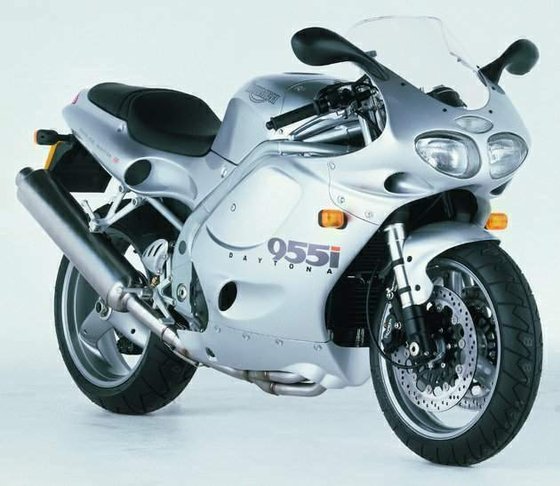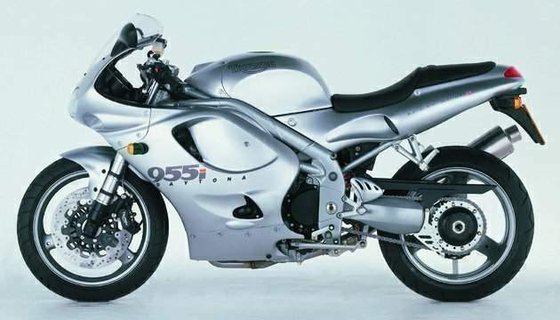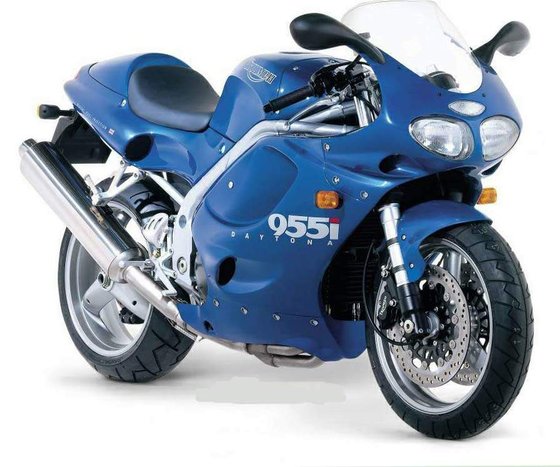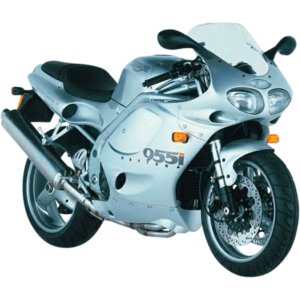Triumph Daytona 955 (1999–2001): A Triple-Cylinder Legend Revisited

Introduction
The Triumph Daytona 955, produced between 1999 and 2001, remains a cult classic among sportbike enthusiasts. With its distinctive inline-three engine, aggressive styling, and a chassis that balances track prowess with road manners, this British icon carved its niche in an era dominated by Japanese four-cylinder rivals. After a spirited test ride on a well-maintained 2001 model, it’s clear why the Daytona 955 still commands respect—and why it’s a compelling choice for riders seeking character alongside performance.
Engine Performance: The Soul of a Triple
At the heart of the Daytona 955 lies its 955cc liquid-cooled inline-three engine—a masterpiece of torque-rich delivery and aural drama. The 12-valve DOHC configuration, developed in collaboration with Lotus, produces 128–147 HP (depending on the model year) and a robust 100 Nm (73.8 lb-ft) of torque.
Throttle Response and Power Delivery
Twist the throttle, and the Daytona rewards with a linear surge of power. Unlike peaky inline-four competitors, the triple’s torque curve is broad and accessible. From 6,000 RPM, the engine pulls hard, eliminating the need for frantic gear changes. During my test ride, the midrange felt particularly addictive—ideal for overtaking or carving through mountain roads. At 9,900 RPM, the engine hits its stride with a wailing crescendo, though it lacks the manic top-end rush of a GSX-R or R1.
The fuel injection (Sagem MC1000 system) deserves praise. Cold starts are drama-free, and throttle transitions are smooth, even when aggressively rolling on/off mid-corner. Triumph’s decision to route intake noise toward the rider via the airbox is a cheeky touch—the growl at 3,000–5,000 RPM is pure mechanical theater.
Top Speed and Gearbox
The Daytona’s claimed 250–270 km/h (155–167 mph) top speed feels achievable with space and courage. On a long straight, the bike settled at an indicated 260 km/h (161 mph) with minimal vibration—a testament to its refined powertrain. The 6-speed gearbox, while improved over earlier models, isn’t as slick as Suzuki’s units. False neutrals occasionally appeared during aggressive downshifts, but the cable-actuated clutch remained light and predictable.
Handling and Dynamics: Precision Meets Personality
The Daytona’s chassis—a tubular aluminum perimeter frame paired with Showa suspension—strikes a balance between agility and stability.
Cornering and Stability
With a 24° rake and 86 mm trail (1999–2000 models), the Daytona steers deliberately, requiring firm input in fast sweepers. The 2001 revision sharpened geometry to 22.5° rake and 79 mm trail, improving turn-in response. During my ride, the bike held its line confidently, though heavy braking mid-corner induced mild understeer—a quirk manageable with proper trail-braking technique.
The fully adjustable 45mm Showa forks and rear monoshock (with remote preload) absorbed bumps admirably. Dialing in 5 clicks of rebound damping eliminated wallowing during hard acceleration out of corners.
Brakes
Dual 320mm front discs with 4-piston calipers provide strong stopping power. Initial bite is progressive, avoiding the wooden feel of older Nissin setups. However, sustained hard riding revealed slight fade—a cue to upgrade to sintered pads or stainless lines (available at MOTOPARTS.store).
Design and Ergonomics: Form Follows Function

The Daytona’s styling polarizes. The 1999–2000 models feature a single-sided swingarm and curvaceous fairing, while the 2001 update introduced a twin-sided swingarm and sharper bodywork. Both generations share a 800–815mm seat height, accommodating riders up to 183cm (6’0”) comfortably.
Practicality
The 18–21L fuel tank (depending on year) offers a 280–350 km (174–217 mi) range—impressive for a sportbike. The interchangeable pillion seat/cowl adds versatility, though the riding position is unapologetically sporty. After 90 minutes, my wrists and knees begged for a break—a small price for the Daytona’s track-ready posture.
Competition: How Does It Stack Up?
The Daytona 955 faced fierce rivals in its era. Here’s how it compares:
Honda CBR900RR FireBlade
- Pros: Lighter, sharper handling.
- Cons: Less torque, generic inline-four character.
Verdict: The FireBlade excels on track, but the Daytona’s triple charm wins on backroads.
Yamaha YZF-R1
- Pros: Brutal top-end power, cutting-edge tech.
- Cons: Harsher ride, less midrange.
Verdict: The R1 is faster, but the Daytona’s torque makes it more enjoyable in real-world riding.
Ducati 916
- Pros: Exotic design, V-twin soundtrack.
- Cons: High maintenance, cramped ergonomics.
Verdict: The Ducati is a style icon, but the Triumph offers reliability and lower running costs.
Maintenance: Keeping the Daytona Thriving
Owners praise the Daytona’s reliability, but proactive care is key:
Key Service Points
- Valve Adjustments: Every 12,000 km (7,456 mi). Shim-under-bucket design requires patience—not a DIY job for beginners.
- Cooling System: Flush coolant every 2 years. Upgrade to a high-capacity radiator for track use.
- Chain Maintenance: The O/X-ring final drive needs lubrication every 500 km (311 mi). Replace with a DID chain for longevity.
Recommended Upgrades
- Exhaust: Swap the heavy stock silencer for a lightweight slip-on (e.g., Arrow or SC Project) to shed 5 kg and amplify the triple’s growl.
- Suspension: Fit Öhlins cartridges or Hyperpro springs to refine damping.
- Brakes: MOTOPARTS.store’s EBC HH sintered pads and Galfer lines reduce fade during spirited rides.
Conclusion: A Timeless Sportbike
The Triumph Daytona 955 isn’t just a motorcycle—it’s an experience. Its triple-cylinder engine delivers a unique blend of torque and soundtrack, while its chassis balances aggression with usability. For riders seeking a distinctive alternative to cookie-cutter inline-fours, the Daytona remains a compelling choice. And with MOTOPARTS.store’s catalog of upgrades, keeping this British legend at peak performance has never been easier.

Whether you’re chasing knee-down glory or simply savoring the symphony of its inline-three, the Daytona 955 proves that character never goes out of style.
Specifications sheet
| Engine | |
|---|---|
| Stroke: | Four-stroke |
| Max power: | 110 kW | 148.0 hp |
| Engine oil: | 15W40 |
| Max torque: | 100 Nm |
| Fuel system: | Multipoint sequential electronic fuel injection |
| Lubrication: | Wet sump |
| Max power @: | 10700 rpm |
| Spark plugs: | NGK DPR8EA-9 |
| Displacement: | 955 ccm |
| Max torque @: | 8200 rpm |
| Configuration: | Inline |
| Cooling system: | Liquid |
| Spark plug gap: | 0.9 |
| Compression ratio: | 12.0:1 |
| Number of cylinders: | 3 |
| Dimensions | |
|---|---|
| Wheelbase: | 1431 mm (56.3 in) |
| Dry weight: | 198 |
| Seat height: | 800-815 mm (31.5-32.1 in) |
| Overall width: | 725 mm (28.5 in) |
| Overall height: | 1165 mm (45.9 in) |
| Overall length: | 2115 mm (83.3 in) |
| Fuel tank capacity: | 18 L (4.8 US gal) |
| Drivetrain | |
|---|---|
| Final drive: | chain |
| Chain length: | 108 |
| Transmission: | 6-speed |
| Rear sprocket: | 43 |
| Front sprocket: | 18 |
| Maintenance | |
|---|---|
| Rear tire: | 190/50 z-17 |
| Front tire: | 120/70 z-17 |
| Brake fluid: | DOT 4 |
| Coolant capacity: | 2.8 |
| Engine oil capacity: | 3.4 |
| Engine oil change interval: | Every 5000km or 2 years |
| Valve clearance (intake, cold): | 0.10–0.15 mm |
| Valve clearance check interval: | 24,000 km / 15,000 mi |
| Valve clearance (exhaust, cold): | 0.15–0.20 mm |
| Recommended tire pressure (rear): | 2.9 bar (42 psi) |
| Recommended tire pressure (front): | 2.5 bar (36 psi) |
| Chassis and Suspension | |
|---|---|
| Frame: | Tubular aluminum perimeter frame |
| Rear brakes: | Single 220 mm disc, 2-piston caliper |
| Front brakes: | Dual 320 mm discs, 4-piston calipers |
| Rear suspension: | Monoshock with adjustable preload, compression, and rebound damping |
| Front suspension: | 45mm Showa inverted telescopic forks, adjustable preload, compression, and rebound damping |
| Rear wheel travel: | 140 mm (5.5 in) |
| Front wheel travel: | 120 mm (4.7 in) |



















